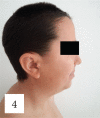PITUITARY STALK INTERRUPTION SYNDROME: REPORT OF TWO CASES AND LITERATURE REVIEW
- PMID: 31149155
- PMCID: PMC6525749
- DOI: 10.4183/aeb.2017.96
PITUITARY STALK INTERRUPTION SYNDROME: REPORT OF TWO CASES AND LITERATURE REVIEW
Abstract
Pituitary stalk interruption syndrome (PSIS) consisting of the triad: ectopic posterior pituitary (EPP), thin or absent pituitary stalk and anterior pituitary hypoplasia is a rare pituitary malformation with variable degrees of pituitary insufficiency, from isolated growth hormone deficiency to TSH, gonadotropin and ACTH deficiency which may occur in time, with normo, hyper or hypoprolactinemia and central diabetes insipidus in up to 10% of cases. Also, extrapituitary malformations have been described in some cases. Genetic defects were identified only in 5% of cases. MRI findings are considered predictive for the endocrine phenotype. We aim to describe two cases with PSIS without central diabetes insipidus, anosmia and extrapituitary malformations, except for minor head dysmorphic features. The first case was referred at the age of 4 years for short stature (-4SDS for height, bone age 2 years), diagnosed with severe GH deficiency and developed central hypothyroidism and hypoprolactinemia during five-years follow-up. The second case, a 26 year old male with birth asphyxia, cryptorchidism, poor growth in childhood and adolescence (-3 to -4 height SDS), absent puberty and normal adult height (-1.18 SDS; bone age 15.5 years and active growth plates) had GH, TSH, ACTH deficiency and low normal PRL levels. Increasing medical awareness on PSIS clinical and endocrine heterogeneity may help a more early and accurate diagnosis. Corroboration of neuroimaging and endocrine data will improve our knowledge and understanding and will create premises for molecular diagnosis, genetic counseling and a better patients' management.
Keywords: hypopituitarism; magnetic resonance imaging; pituitary stalk interruption syndrome.
Conflict of interest statement
The authors declare that they have no conflict of interest concerning this article.
Figures







References
-
- Fujisawa I, Kikuchi K, Nishimura K, Togashi K, Itoh K, Noma S, Minami S, Sagoh T, Hiraoka T, Momoi T. Transection of the pituitary stalk: development of an ectopic posterior lobe assessed with MR imaging. Radiology. 1987;165(2):487–489. - PubMed
-
- Triulzi F, Scotti G, di Natale B, Pellini C, Lukezic M, Scognamiglio M, Chiumello G. Evidence of a congenital midline brain anomaly in pituitary dwarfs: a magnetic resonance imaging study in 101 patients. Pediatrics. 1994;93(3):409–416. - PubMed
-
- Voutetakis A, Sertedaki A, Dacou-Voutetakis C. Pituitary stalk interruption syndrome: cause, clinical manifestations, diagnosis, and management. Curr Opin Pediatr. 2016;28(4):545–550. - PubMed
-
- Castinetti F, Reynaud R, Quentien MH, Jullien N, Marquant E, Rochette C, Herman JP, Saveanu A, Barlier A, Enjalbert A, Brue T. Combined pituitary hormone deficiency: current and future status. J Endocrinol Invest. 2015;38(1):1–12. - PubMed
-
- Castinetti F, Reynaud R, Saveanu A, Jullien N, Quentien MH, Rochette C, Barlier A, Enjalbert A, Brue T. Mechanism in endocrinology: An update in the genetic aetiologies of combined pituitary hormone deficiency. Eur J Endocrinol. 2016;174(6):R239–R247. - PubMed
LinkOut - more resources
Full Text Sources
